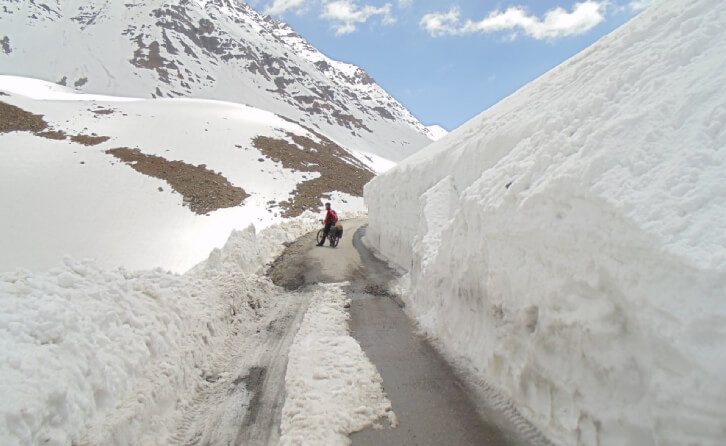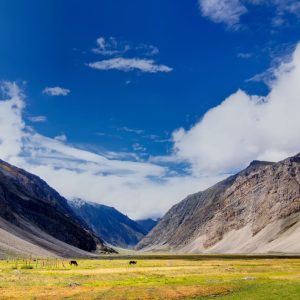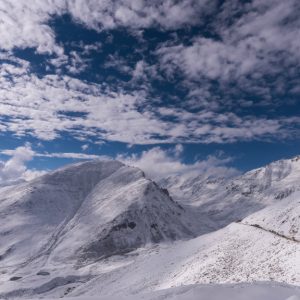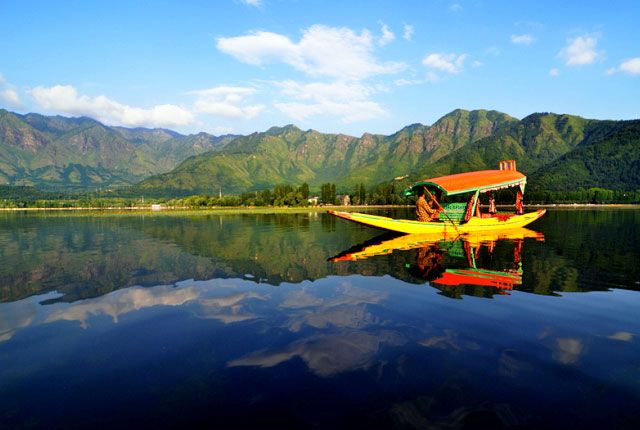
Ladakh in January
Table of Contents
ToggleOverview
Ladakh, which lies in India’s northernmost region, is one of the most spectacular parts of the world with its stunning combination of ancient monasteries, exquisite lakes, and snow-capped mountains forming its unique landscape. Known for its barren yet astonishing beauty, Ladakh becomes an entirely different world in winter, especially in the month of January. During winter season, it offers an unparalleled experience of adventure, beauty, and peace. While January Ladakh offers serene untouched beauty, harsh weather accompanies the region during that time too.
January gives a chance to experience the serene and raw beauty of Ladakh but offers different extremes to those daring enough to embrace the cold. At that time, trekking on the frozen Zanskar river and participating in local festivals become options. This guide will help cover the essentials needed to travel to this mesmerising part of the world in the winter season.





Why Visit Ladakh in January?
January is yet another ideal time to visit Ladakh in contrast to distant June. Snow-covered peaks and crisp cold air gives a sense of stillness that is usually hard to find at other crowded periods.
Here’s why every adventure lover’s dream should include a visit to Ladakh in January:
- Fewer Tourists: January is off peak season in Ladakh, which means less tourists. If you need silence, solitude, and tranquility then this is the time for you. It provides you accessibility towards nature which is not possible in peak season.
- Cultural Immersion: Winter is also the time when Ladakhis celebrate their New Year through festivals like Losar, which creates for a great time for anyone looking to indulge in local culture.
- Snow-Capped Peaks and Frozen Landscapes: Ladakh’s dramatic landscapes are even more breathtaking when laden with snow. The majestic Himalaya’s peaks bound with frozen lakes and snow covered roads creates a picturesque winterland which is just right for exploration and photography.
Ladakh Weather Guide - January
Ladakh can be brutally cold in January, with temperatures frequently plummeting below freezing point. Ladhak can be intensely chilly, but its rugged beauty in winter makes the discomfort worthwhile.
Temperature and Climate
Daytime Temperatures: Towards day, the temperature of Ladakh ranges from -5 degrees to -10 degrees at higher altitudes. If luck is on your side, the sun may shine for a while, but don’t let that fool you! The air will still remain cold, so make sure to wear out during the day.
Nighttime Temperatures: For specific areas, nights in Ladakh can be exceptionally freezing beneath -20 degrees. Nights are practically a fight against the extreme temperatures sleeping underneath insulating clothes while completely intertwined in blankets.
Snowfall: January brings in abundant snowfall, particularly in the higher altitudes. Although the heavy snow at times can block the roads, making traveling incredibly tough, the beauty of the snow covered region is truly unrivaled.
Wind Chill: At higher altitudes, Ladakh particularly is always chilly due to the wind chill. When at these altitudes, protecting your skin and keepong warm should be the number one priority.
What To Pack For A Trip To Ladakh In January
Because of low temperatures, one would have to think ahead for packing before heading to Ladakh. Here is a detailed list that guides you through the conditions you might encounter:
Clothes
Thermals: Consider using layering strategically. High quality thermal wear will be your best bet.
Woollen Clothes: Make sure to have woolen sweaters, fleece jackets, as well as a woolen scarf. All of these will prove to be useful.
Waterproof Outerwear: For snow, you’ll want to invest in either a good waterproof jacket or a down jacket. They will not only keep you dry, but also warm.
Gloves and Mittens: The gloves you choose should not only be insulated, but also waterproof. You might want to wear a liner under them for extra warmth.
Hats and Beanies: Consider wearing woolen beanies or hats. These will do a lot to protect your ears and head from the cold.
Footwear: You’ll absolutely need to buy insulated, waterproof boots. The harsh cold will seep through even the best shoes, so you’ll need boots that can handle snow and below freezing temperatures.
Socks: Woolen socks are a given, however, you will need a decent amount of them. You should also try to find moisture-wicking socks that don’t allow your feet to get wet.
Sunglasses and Sunblock: Even if it’s winter, looking into the sun can prove to be harmful. Make sure your eyes are protected at all times due to intensity of the sun’s rays reflecting of snow.
Other Essentials
Backpack with Rain Cover: A good quality backpack with a durable covering protects your equipment from snow and cold.
Thermal Water Bottles: Water is likely to freeze in extreme cold. Consider a thermal bottle that can keep the water warm.
Medicines: Carrying essential medicine along with the first aid kit or altitude sickness pills is mandatory since Ladakh’s height and extreme temperatures can be tough on the body.
Portable Power Banks: With the extreme temperature, batteries drain fast so make sure to have additional power banks to charge phones and cameras.
Top Places to Visit in Ladakh in January
The exquisite beauty of Ladakh’s winter landscape has a completely different feel which makes it worth exploring during January. While there are many attractions in the region that are open throughout the year, the winter months have their own charm as well. Let’s dive deeper into the beauty that Ladakh holds for January.
1. Leh Town
In Ladakh province lies its capital Leh, which is a perfect starting point for any traveler. January gives the town a very serene look with snowcapped peaks around it. Some of the well known landmarks include Shanti Stupa, Leh Palace, and the Spituk and Namgyal Tsemo monasteries. The calmness of the town is sure to give the visitors a taste of Ladakhi culture, food, and religion.
- Monasteries: Apart from Ladakhi culture, Leh is also well known for its important Buddhist monasteries including Hemis Monastery, Thikey Monastery, and Likir Monastery. The beauty of these ancient monasteries during winter is unmatched, especially with the snow filled Himalayas in the background.
- Local Markets: Unlike the other towns of Ladakh, the Leh market remains open during winters for people to buy local handicraft items, as well as souvenirs like Pashmina shawls, and traditional Ladakhi accessories.
2. Pangong Lake
Pangong Lake is one of these stunning destinations and looks breathtaking during winters when frozen. Sitting at an altitude of around 4300 meters, this water body looks stunning in January. Instead of the deep blue color its water usually is, in winter it turns into a glittering sheet of ice.
- Beauty Frozen: Walking on the frozen lake gives one the chance to explore the views of the snow-clad mountains. It’s one experience that would give anyone a breathtaking feel.
- Photography: Photographers would appreciate the stunning views of the snow covered mountains and the frozen lake making it perfect for photography.
3. Nubra Valley
Nubra Valley sits between the meeting of Shyok and Nubra rivers, another appealing place of Ladakh. In winter season, Nubra Valley is quiet, peaceful, blanketed in white and gives one a break from the sound typical from tourist places.
- Bactrian Camel: In spite of the cold, you can still find people riding Bactrian camels on the sand dunes blanketed with snow in Hunder, Nubra Valley.
- Turtuk Village: If you wish to go further, Turtuk, which is a serene village located in Nubra Valley, allows one to immerse themselves in the captivating scenery and Balti culture.
4. Zanskar Valley and Chadar Trek
Zanskar Valley is known as one of the hidden and gorgeous places in Ladakh. Best to start Chadar Trek in January where one will have to walk on the Zanskar River, which has frozen over. This amazing trek is for those who enjoy the outdoors as one can walk along a frozen river surrounded by cliffs and land of snow.
- Chadar Trek: The Chadar Trek is a stunning and unique trek that takes in the remote villages and magnificent frozen waterfalls of Ladakh. This trek is one of the most challenging ones around, requiring eight days to complete and passing through a river bed that’s frozen over.
5. Tso Moriri Lake
Like all of the other lakes found in the region, Tso Moriri marks yet another breathtaking addition to the landscape of Ladakh. The lake reaches an elevation of 4,595 meters, or 15,075 feet, and is the highest located lake exclusively in India. Its tranquil atmosphere is further amplified in January, when it freezes over.
- Remote Tranquility: This lake is far quieter during the winter months and has far fewer visitors, allowing for a tranquil experience.
6. Hemis Monastery
Hemis Monastery is located next to the city of Leh in Ladakh, making it one of the most well-known monasteries in the region. It remains accessible throughout the year, but January is by far the most appealing month to visit it due to the tranquility it offers.
January Adventure Activities In Ladakh
Even in the winter months, there is no shortage of adventurous activities in Ladakh. In January, the Zanskar River becomes a frozen trek and ice climbing on frozen water- falls becomes reality. Here’s a list of some exhilarating activities to check out:
- The Chadar Trek
In winter, the Chadar Trek is one of the most popular treks in Ladakh. The trek consists of walking the frozen Zanskar River and its steep, rugged surroundings. The trek is around 105km long and takes 8 days to complete.
- Ice Climbing
Ladakh is best known for its unique activities and ice climbing is one of them. The frozen waterfalls in Leh and Nubra Valley make it an ideal place for this adventurous activity. Ladakh has beginner and advanced level courses to teach you the necessary skills to scale an ice covered rock face.
- Winter Trekking
January offers low foot traffic and gives way to a number of less popular trekking routes. The Markha Valley and Stok Kangri treks are some of the popular winter treks that are less traveled and allow you to enjoy the serene beauty of Ludakh’s snow capped, icy, rugged terrains.
- Snow Camping
If you are looking for a deeper experience, then winter camping in Ladakh is something that you won’t forget. You can set up camp under the blazing stars in the snowy wilderness that gives you a beautiful taste of adventure. There are camping sites around places like Pangong Lake, Nubra Valley and Tso Moriri Lake.
Health and Safety Guidelines for January Travel to Ladakh
Ladakh in January is full of excitement and offers an experience of a lifetime. However, the extreme cold clawing at you and the height could be a challenge for most travelers. Here are some important health and safety tips.
- Acclimatization
Ladakh is a region at considerable height, Leh itself is above 3,500 m (11,500 ft). It’s key to make an acclimatization plan so that you can height sick. Making altitude is possible without enabling altitude sickness; so spend a minimum 2-3 days in Leh before making higher ascents.
- Hydration and Nutrition
Extreme cold weather, makes some people less thirsty, but dehydration is still a risk when it comes to high altitudes. So drink lots of water and make sure that you take enough calories to keep your blood sugar high. While trekking make sure that you carry energy bars and dry fruits.
- First-Aid Kit
While packing for the trip make sure you have a first-aid kit that has altitude sickness medicines, cold-weather injuries (like frostbite), and a few common illness medicines.
- Travel Insurance
Considering the remoteness of Ladakh, as well as the risks that its extreme environment poses, it is always a good idea to have insurance while traveling. Make sure that your policy includes provisions for emergencies arising out of altitude sickness and accident injuries while trekking or climbing.
Conclusion
For travelers seeking to break away from the mundane and indulge in ethereal vibes is Ladakh in January. The frozen lakes combined with amazing treks in winter provide a wonderful experience for extreme adventurists. From walking over the Chadar to camping under the canopy of stars, from admiring pristine snowscapes to basking in the glory of the mountain range, Ladakh guarantees unforgettable moments in one’s winter sojourn. Hence warm clothing is a must, brace yourself for the cold and get ready to travel to this magnificent wonderland.
How to book Ladakh tour?
Contact a travel agency that specializes in Kashmir tours. You can reach out to the following for assistance:
- Phone:
- +91 7889 655596
- +91 7006 891267
- Email:
Inquire about tour packages, itineraries, and pricing, and confirm your booking for a memorable winter experience!
People Also Ask
What is the best time to visit Ladakh?
The best time to visit Ladakh is between June and September when the weather is more moderate, and most of the region’s roads and attractions are accessible. However, for those seeking a unique experience, Ladakh in January offers a magical winter wonderland.
Is it safe to visit Ladakh in January?
Yes, Ladakh in January can be safe for experienced travelers who are well-prepared for the harsh winter conditions. However, the weather can be extreme, and it’s important to pack appropriate clothing, acclimatize to the altitude, and stay updated on road conditions and weather forecasts.
How cold is Ladakh in January?
In January, Ladakh experiences extreme cold. Daytime temperatures range from -5°C to -10°C (23°F to 14°F), while nighttime temperatures can drop to -20°C or even lower in some areas, especially at higher altitudes.
What is the Chadar Trek in Ladakh?
The Chadar Trek is a famous winter trek in Ladakh, where trekkers walk on the frozen Zanskar River. This challenging trek takes you through dramatic landscapes and frozen waterfalls, offering a unique and thrilling adventure.
How do I get to Ladakh in January?
The most convenient way to reach Ladakh in January is by flying into Leh Airport (Kushok Bakula Rimpochee Airport). The Srinagar-Leh Highway may be open but is often challenging due to snow, and the Manali-Leh Highway is closed in winter.
Are the roads to Ladakh open in January?
Most roads to Ladakh are closed in January due to heavy snowfall. The only road that may remain open is the Srinagar-Leh Highway, but this route can be treacherous, and road conditions should be checked before planning your travel.
What are the popular places to visit in Ladakh in January?
Popular places to visit in Ladakh in January include Leh town, Pangong Lake, Nubra Valley, Zanskar Valley, Tso Moriri Lake, and Hemis Monastery. These locations are known for their snow-covered landscapes and serene beauty during the winter months.
Can I visit Pangong Lake in January?
Yes, Pangong Lake is accessible in January, but the lake is frozen, offering a unique winter experience. Roads may be closed, so it’s essential to check the weather conditions and travel routes before planning your trip.
Is it possible to trek in Ladakh in January?
Yes, trekking in Ladakh during January is possible, with activities such as the Chadar Trek (frozen Zanskar River trek), winter trekking in areas like Markha Valley, and ice climbing. However, these activities require proper preparation and acclimatization due to the extreme conditions.
What should I pack for Ladakh in January?
For a trip to Ladakh in January, pack thermal wear, woolen clothes, insulated jackets, waterproof gloves, warm boots, hats, sunglasses, and sunscreen. Don’t forget essentials like a first-aid kit, high-quality water bottles, and extra power banks.
Can I travel to Nubra Valley in January?
Nubra Valley can be visited in January, but the region experiences heavy snowfall, which makes it even more beautiful. You can enjoy the frozen rivers, snow-covered dunes, and the famous Bactrian camels, but be prepared for harsh weather.
What kind of accommodation is available in Ladakh in January?
Accommodation in Ladakh during January may be limited as many guesthouses and hotels close due to the harsh weather. However, there are still a few options available in Leh, and you can find homestays and guesthouses that remain open to cater to winter tourists.
Is it necessary to acclimatize in Ladakh?
Yes, acclimatization is essential when visiting Ladakh due to its high altitude (Leh is at around 3,500 meters). Spend at least 2-3 days in Leh before heading to higher altitudes to avoid altitude sickness.
What are the best winter activities in Ladakh?
Popular winter activities in Ladakh include the Chadar Trek, ice climbing, winter trekking, camping, and participating in local winter festivals like the Losar Festival (Ladakhi New Year). These activities offer unique experiences in the pristine winter landscapes.
How is the Losar Festival celebrated in Ladakh?
The Losar Festival marks the Ladakhi New Year and is celebrated with traditional dances, music, and feasts. Locals wear colorful attire, perform cultural rituals, and engage in community gatherings, offering visitors a unique cultural experience.
What is the cost of traveling to Ladakh in January?
The cost of traveling to Ladakh in January can vary depending on your travel style, accommodation preferences, and activities. On average, budget travelers can expect to spend between INR 10,000-15,000 per day, while luxury travelers may spend upwards of INR 20,000-30,000.
Are there any health precautions to take before visiting Ladakh in January?
Before visiting Ladakh in January, ensure that you’re in good health and consult a doctor if necessary, especially for altitude-related issues. Carry medication for altitude sickness and make sure to hydrate well and eat nutritious food.
Can I drive from Manali to Leh in January?
The Manali-Leh Highway is closed in winter due to heavy snowfall, so it is not possible to drive from Manali to Leh in January. The only road that might be open is the Srinagar-Leh Highway but check road conditions before traveling.
What are the risks of traveling to Ladakh in January?
The risks of traveling to Ladakh in January include extreme cold, snowstorms, road closures, and altitude sickness. It’s important to be well-prepared and informed about the weather conditions to ensure your safety.
Are there any specific festivals in Ladakh in January?
The Losar Festival, which marks the Ladakhi New Year, takes place in January. This festival is an important cultural event in Ladakh, featuring traditional dances, music, rituals, and celebrations that showcase the region’s rich heritage.
Can I visit Tso Moriri Lake in January?
Yes, you can visit Tso Moriri Lake in January, but the lake will be frozen, offering a peaceful and serene atmosphere. The route to Tso Moriri may be challenging due to snow, so be prepared for road conditions.
How do I manage the cold weather in Ladakh?
To manage the cold weather in Ladakh, dress in layers, including thermals, woolen clothes, and waterproof, insulated jackets. Protect your face, hands, and feet from frostbite by wearing appropriate gloves, scarves, and footwear. Stay hydrated and avoid alcohol, as it can increase the risk of cold-related injuries.
What is the altitude of Leh, and how does it affect visitors?
Leh is situated at an altitude of approximately 3,500 meters (11,500 feet). At this altitude, there is a risk of altitude sickness, especially for first-time visitors. It’s essential to acclimatize by spending a few days in Leh before heading to higher regions of Ladakh.
Is it possible to go camping in Ladakh in January?
Yes, winter camping in Ladakh is possible and offers a unique experience. However, winter camping in January requires specialized gear, such as high-quality sleeping bags, insulated tents, and proper warm clothing to withstand the freezing temperatures.
Can I see wildlife in Ladakh in January?
Wildlife sightings are rare in Ladakh during January, as many animals hibernate or move to lower altitudes to avoid the extreme cold. However, you might see a few hardy species like snow leopards, ibexes, and migratory birds, particularly in areas like Hemis National Park.
How do I prepare for altitude sickness in Ladakh?
To prevent altitude sickness, spend a couple of days in Leh for acclimatization, drink plenty of water, avoid heavy meals or alcohol, and take it slow for the first few days. If you experience symptoms like headaches or nausea, it’s important to rest and seek medical help if needed.
Can I experience the local culture of Ladakh in January?
Yes, visiting Ladakh in January offers a chance to experience the local culture in its raw and traditional form. The Losar Festival is a great time to witness Ladakhi music, dance, food, and community celebrations, all of which provide deep insight into the region’s rich heritage.
How do I book a trip to Ladakh in January?
You can book a trip to Ladakh in January through various travel agencies or by planning independently. It’s recommended to book flights to Leh well in advance and check on accommodations that remain open during the winter months. For adventure activities like the Chadar Trek, it’s best to book guided tours through specialized operators.
Is Ladakh accessible by bike in January?
Riding a bike to Ladakh in January is not recommended due to the extreme cold and snow-covered roads. The Manali-Leh Highway is closed, and even the Srinagar-Leh Highway can be treacherous. However, local bike rentals are available in Leh for riding within the town or surrounding areas if you have the proper gear and experience.




